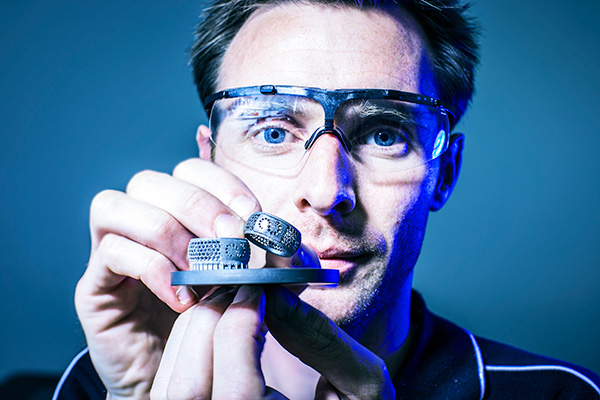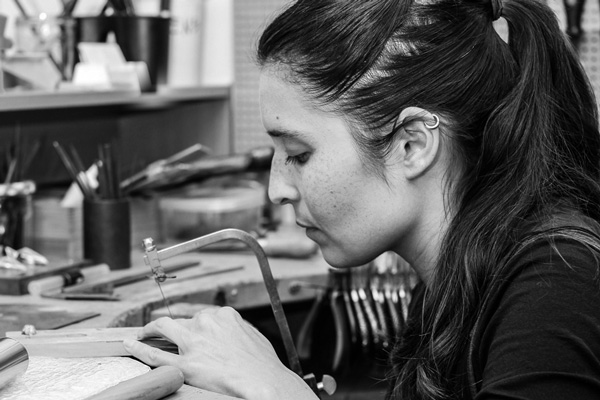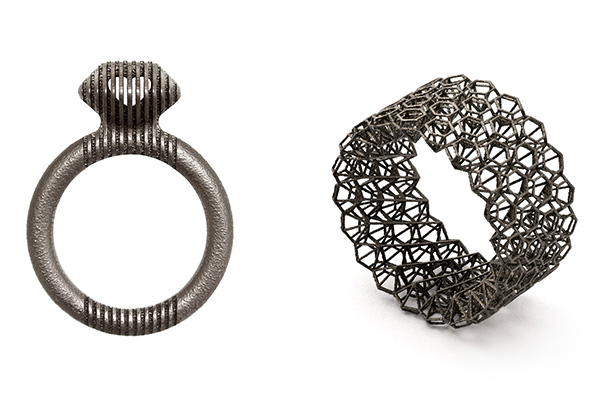September 11, 2014
3D printers have a certain ring about them
A scientist and metalsmith are taking advantage of 3D printing to create bespoke jewellery and art pieces.

Dr Stephen Beirne with examples of in-house designed and 3D-printed titanium rings to demonstrate the capability of the technology.
An unlikely marriage of art and engineering has made the impossible possible, with unique and intricate titanium rings created using 3D printing technology
The UOW-headquartered (ACES) has been at the forefront of using 3D printing technology in developing tools and techniques that push the boundaries of research into medical implants, solar cells and batteries as well as new manufacturing methods.
ACES Research Fellow and (ANFF) Additive Fabrication Manager Dr Stephen Beirne and the UOW-based team was approached about two years ago with an engineering challenge completely removed from any previous biomedical research or device prototyping they had previously encountered.
Illawarra-based metalsmith was an early adopter of 3D printing technology and was using 3D modelling software to generate accurate technical drawings of her designs, approached Dr Beirne to help her directly fabricate her increasingly complex creations.
“As a metalsmith, the capabilities of 3D modeling and additive fabrication offer exciting new potential for metal fabrication, removing the restrictions associated with more traditional subtractive processes,” Lee said.
“Three-dimensional printing allows me to produce jewellery that combines geometric complexity with structural integrity that would be impossible to create any other way.
“I can execute ideas that would have not been possible before.”
Novel and curious designs were not reason alone for Lee to harness the power of 3D printing. For her, 3D printing was not about saving time or money, it was a new way of being able to realise her creative vision and holding true to her traditional craft background.

Illawarra-based metalsmith Cinnamon Lee was an early adopter of 3D printing technology and was using 3D modeling software to generate accurate technical drawings of her designs. Photo: Scott Ehler
“When you look at many printed products, often the only reason people say they use 3D printing is 'because you can’ and I have never settled for that as a good enough reason to do something, especially when it comes to generating yet more objects.”
Dr Beirne said the jewellery project was a clear example of the complete cycle of fundamental research through to prototype and eventually a product.
“In many ways this is the perfect marriage, pun intended, of engineering and the creative arts,” Dr Beirne said. “Three-dimensional printing provides a set of tools available to the engineer – and now the artist - that we can apply to design and build objects that are smaller, more complex than perhaps previously impossible to build using traditional methods.
“It doesn’t matter that we are printing jewellery, the engineering design approach for the rings is very similar to how we approach any project. We still have to ask questions and solve problems about the machine constraints, material composition to allow fabrication of complex design features.”

Cinnamon Lee's titanium rings 3D printed by Dr Beirne with assistance from UOW additive fabrication technician Fletcher Thompson. Photo: John Lee
The UOW-based ANFF equipment includes a 3D printer capable of fine details, or resolution, with various metals as small as 0.15 millimetres (150 microns).
The 3D printing equipment and expertise is made available through the support of the Materials Node of the Australian National Fabrication Facility (ANFF), which provides researchers and industry across Australia with access to state-of-the-art fabrication tools and knowledge through eight university-based locations.
To produce the rings, a printing process called selective laser melting deposits and fuses titanium in powder form layer-by-layer on a metal bed following the 3D model drawn on specialist software.
When the process is complete the excess powder is blasted away revealing the final object, which is then finished by hand.
“Three-dimensional printing hasn’t so much thrown out the design and manufacturing rule book as torn out a few chapters,” Dr Beirne said.
Lee also sees 3D printing, not as a replacement of older methods, but as a new element in her toolbox.
“I see myself as a traditional artist in the sense that all my work is motivated by the desire to express an idea and therefore always has a conceptual basis,” she said. “In that sense 3D printing has not changed my view of my artistic practice, but it has certainly altered the way I am able to execute my ideas.”